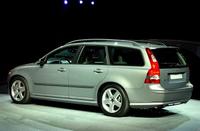2005 Volvo V50 T5 - Review
THE AUTO PAGE By JOHN HEILIG
SPECIFICATIONS
MODEL: Volvo V50 T5
ENGINE: 2.5-liter light turbocharged
5-cylinder
HORSEPOWER/TORQUE: 218 hp @ 5,000 rpm/236 lb.-ft. @ 1,500-4,800
rpm
TRANSMISSION: 6-speed manual
WHEELBASE: 103.9 in.
LENGTH x WIDTH x
HEIGHT: 177.7 x 69.7 x 57.2 in.
TIRES: P205/50R17
CARGO VOLUME: 14.7-46.2 cu. ft.
PRICE: $30,000 (est.)
Stepping into the Volvo V50 wagon was a bit like déjà vu. The week before I had driven the S40 sedan, which is the identical car in sedan form. The difference – and a big difference – is that the S40 was AWD and the V50 was front wheel drive. And that’s important in winter. So I drove the V50 around my home town and over some of my favorite roads and found that traction was not as good as in the S40 and handling was slightly poorer.
Cargo capacity, of course, was improved. The V50 can run with two rows of seats, one row of seats, or just the driver’s seat up. All the folded seats fold flat for maximum carrying capacity. With the rear seat up, it’s 14.7 cubic feet; with the rear seat down it’s 25.3 cubic feet; and with the front seat and second row seat folded cargo capacity increases to a huge 46.2 cubic feet. And you get this capacity in a sleek wagon that looks as slick as the sedan.
The V50 is well-balanced and handles very well on dry pavement. The 6-speed manual gearbox was a pleasure to use. It was smooth and I never messed up a shift. Inside the V50 was roomy, especially for front-seat passengers, and had the same unique collection of design surprises that can be found in the sedan – like the center stack, which is unlike that in any other non-Volvo.
The seat material is allergy-free, It’s a nylon with what appears to be leather trim. It has the feel of eternal life, looks great, and the seats themselves are comfortable.
But I was really concerned about the reduced traction caused by the front wheel drive. Volvo to the rescue.
I left the V50 in my driveway at home, hopped a couple of planes, and found myself in Quebec City, where Volvo was conducting a Winter Driving Experience. The vehicles were an XC70 semi-sport utility and, ohmigod, a V50 AWD. So thanks to exquisite timing, I had an opportunity to drive a V50 AWD in some serious winter weather and roads.
On snow-covered roads – and they weren’t that covered because Quebec is excellent at clearing roads after snowstorms – the V50 performed extremely well. Traction was excellent, even if it was a step down from the XC70. The V50 uses Volvo’s optional DSTC – Dynamic Stability Traction Control – for improved traction control.
We drove the V50 on an ice lake with and without DSTC. Naturally, without DSTC we skidded all over the place, despite a thin layer of snow on the ice. Every now and then we’d hit glare ice and go wandering off into a small snow bank. With the DSTC we were able to go 15-20 kph faster over the same course without sliding off into the snowbanks.
A later exercise had us on snow, driving a slalom course (oddly, at a ski resort). We were able to drive the V50 the same as we would have any other car on dry pavement, if a bit slower. My personal times were good and the only problem I had was when I tried to be smart and do a power u-turn at the end for the return run. I ended up powering too much and lost a couple of seconds.
Later still, I pulled to the side of the road to exchange drivers and found myself stuck in a snow bank. Even AWD vehicles can get stuck. As luck would have it, an XC70 with three Volvo techs was following us and jumped to the rescue. I didn’t realize it, but they popped a small square panel in the front bumper of the V50 and one in the rear bumper of the XC70. Inside was a receiver into which you can insert a screw with an eyelet at the end. The technicians attached a tow cable to both eyelets and in no time had us out of the snowbank. A feature like this can be of great use in any emergency, but it was important to us when the temperature was in the vicinity of –200 C.
Thanks to Volvo for both the FWD V50 and the experience with the AWD V50. I discovered that AWD is the way to go with this vehicle. Pricewise, AWD adds about $1,775 to the base price of the V50 T5, but it’s well worth it. As far as I’m concerned, if the feature is available and it makes driving safer, get it.
© 2005 The Auto Page Syndicate



